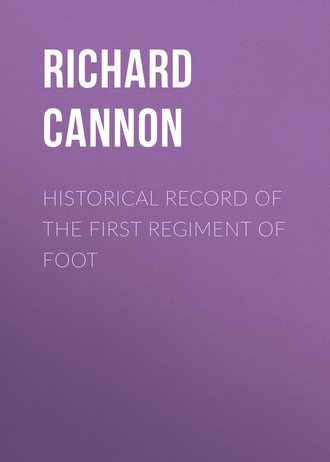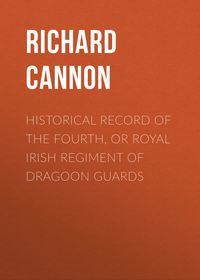 полная версия
полная версияHistorical Record of the First Regiment of Foot
Meanwhile the two companies of the Royal Scots left at Fooltaumba, under the command of Lieutenant Bland, had marched with a body of troops, under Lieut. – Colonel M'Dowall, of the East India Company's service, into the Candeish country, and had captured the fort of Unkye, situated on the summit of the Candeish Ghats, also the forts of Rajdeir and Inderye, in which service the two companies had a few private men wounded. They were next engaged in the reduction of the strong hill-fort of Trimbuck, situated near the source of the river Godavery, which surrendered on the 25th of April; their loss on this occasion was 1 serjeant, 1 drummer, and 8 private men, wounded. The conduct of the Royal Scots in this service was spoken of in terms of commendation in detachment orders. The capture of Trimbuck was followed by the surrender of seventeen other forts.
After this service the detachment proceeded to the strong fort of Malleygaum, situated on the river Moassum, and defended by a party of the Arabs, who surrendered to Brigadier-General Doveton at Nagpore. This place was defended by two lines of works, with very high walls, the inner one of superior masonry and surrounded by a ditch 25 feet deep and 16 feet wide. On the 18th of May a sortie of the garrison was repulsed; and on the 19th two batteries opened their fire. A breach having been effected, an attempt was made to carry the fort by storm: 2 officers and 50 rank and file of the Royal Scots, commanded by Lieutenant Bland, formed part of the principal storming party against the breach, and Lieutenant Orrock and 25 rank and file part of a column destined to make an attack on another point; but success was found impracticable, and the storming party was withdrawn. Another point of attack was afterwards selected, and new batteries raised. Two of the enemy's magazines having been blown up, the garrison surrendered, and the British flag was hoisted on the walls of Malleygaum, on the morning of the 13th of June. The Royal Scots lost in this siege 5 rank and file killed; Ensign Thomas, 1 serjeant, 1 drummer, and 11 rank and file, wounded.
1819The whole of the hill-forts in the Candeish being reduced, the two companies of the Royal Scots proceeded to Jaulnah, and joined the other three companies of the battalion, with the Hyderabad division at that place. Here the troops expected to take up their monsoon quarters; but, when all who were obliged to live under canvass were busily engaged in making arrangements to mitigate the severity of the approaching rains, the division was ordered to proceed with all possible expedition to Nagpore. Quitting Jaulnah on the 7th of August, the troops commenced the march, and the dreaded rains immediately set in; the roads became almost impassable; the baggage was unable to keep up with the troops, and the tents were consequently in the rear, so that the men were frequently exposed for twenty-four hours to incessant rain; no shelter could be procured in the villages, and every comfort was wanting. Exposed to these calamities, the troops arrived at Ellichpoor on the 3rd of September in such a state as to be totally unfit to proceed any further. Here they halted until the 21st of December, when they were again put in motion, and halted at Walkeira on the 30th, where the five companies of the Royal Scots were, in consequence of their long service in the field, relieved by a division of His Majesty's 30th regiment from Hyderabad. The five companies then returned to Jaulnah, expecting to continue their march to the Deccan, but were ordered to proceed to Boorhaunpoor in charge of a battering train which lay at Jaulnah. On the 1st of March, 1819, they rejoined the Hyderabad division, encamped near the city of Boorhaunpoor, and marched to engage in the siege of the celebrated fortress of Asseerghur, which, on account of its strength, was termed "the Gibraltar of the East." This fortress is situated on a detached hill, not commanded by any other in its neighbourhood. It consists of an upper and lower fort; the upper one, of an irregular form, about 1100 yards from east to west, and about 600 from north to south; it crowns the top of the hill, which is about 750 feet in height; and all round it, with the exception of one place which is strongly fortified, there is a perpendicular precipice from 80 to 120 feet, surmounted with a low wall full of loop-holes. Below this are two lines of works, the outer one forming the lower fort, which rises directly above the pettah, and the entrance to which is protected by strong gateways and flanking works; and immense labour and great skill had been employed in rendering this naturally strong post almost impregnable. Such was the formidable fortress against which the five companies of the Royal Scots were about to be employed.
The Hyderabad division was encamped at Neembolah, about seven miles from this celebrated fortress, belonging to his Highness Doulat Rao Scindia, and, negotiations having failed, about twelve o'clock on the night of the 17th of March, five companies of the Royal Scots,129 commanded by Captain J. Wetherall, with the flank companies of the 30th, 67th, and Madras European regiments, five companies of native infantry, and a detachment of sappers and miners, the whole commanded by Lieut. – Colonel Fraser, of the Royal Scots, and a reserve, commanded by Major Dalrymple, of the 30th, assembled at the camp for the attack of the pettah of Asseer; another party was also directed to co-operate in this service from Sir J. Malcolm's division.
Between one and two o'clock the column commenced its march; advancing up the bed of a deep nullah, or small river, nearly dry at the time, the assaulting party arrived unobserved within 500 yards of the pettah, then rushed upon the gate with the greatest ardour and steadiness, the five companies of the Royal Scots leading the way. The enemy was surprised, and, after discharging a few rounds of grape, retired without making further opposition. The head of the attacking column forced the gate, and, proceeding up the main street, encountered an advanced piquet of the enemy, which retired to the lower fort, firing occasionally at the head of the column. Major Charles M'Leod, of the East India Company's service, Deputy Quartermaster-General, acted as guide on the occasion, and by his direction the leading files of the Royal Scots pursued the enemy close under the walls of the fortress, from whence an incessant fire of artillery and matchlocks was kept up, and a few ill-directed rockets were also discharged. The leading sections of the Royal Scots, which had pursued the enemy up the hill, were joined by one or two files of the 30th and 67th regiments, the whole amounting to about 25 or 30 men; and as soon as the enemy saw the small force before which they had so precipitately fled, they immediately rallied, and came shouting down the hill with augmented numbers to attack this small party, but were repulsed by a spirited charge with the bayonet, which, with a few rounds of musketry, obliged them to retreat within the works, some of which were within 50 or 60 yards of this handful of men, leaving their chief, who was shot by a soldier of the Royal Scots, and several men, on the ground. Major M'Leod, being wounded, proceeded to the rear; and the enemy having established a cross fire from the walls of the lower fort and from two cavaliers, Captain Wetherall ordered the advanced party to retire a short distance to a post established by Lieut. – Colonel Fraser, where there was some cover for the men. The loss of the leading sections in this affair was 1 private soldier killed; Major M'Leod, Lieutenant Bland, and 11 rank and file, wounded. The remainder of the column did not sustain any loss, the men being protected from the enemy's fire by the houses in which they had established themselves.130
The assaulting party maintained its post until night, when it was relieved by fresh troops, and the five companies of the Royal Scots returned to their tents, which had been left standing at Neembolah; but Lieut. – Colonel Fraser remained in command of the troops at the pettah. At day-break on the 19th a heavy gun battery opened against the fort. At dusk in the evening a party of the enemy issued from the lower fort, crept unperceived down a deep ravine to the rear of the pettah, and gained the main street, where they encountered the British troops, and were repulsed and forced to abandon their enterprise. Lieut. – Colonel Fraser, of the Royal Scots, while in the act of gallantly encouraging the soldiers, and directing them to withhold their fire and give the enemy the bayonet, was shot in the head and fell dead on the spot: his body was afterwards conveyed to the camp at Neembolah and interred with military honours.131
On the 21st of March the five companies of the Royal Scots took their turn of duty in the pettah, where they arrived a little before day-break. As soon as it was light a heavy gun battery opened on the forts with great effect, but it had only fired about a dozen rounds when, from some accident which could not be explained, the magazine in the rear of it, containing 130 barrels of gunpowder, exploded, killing a conductor of ordnance, a native officer, and 34 non-commissioned officers and rank and file, and wounding another native officer and 65 non-commissioned officers and rank and file. Such was the violence of the explosion that about six inches of the top of a bayonet was blown nearly six hundred yards from the battery. From this period until the 29th new batteries of heavy guns and mortars were erected, and, a breach having been effected in the wall of the lower fort, the enemy abandoned it and retired to the upper one: the lower fort was taken possession of on the morning of the 30th by part of Sir John Malcolm's division.
The Royal Scots, with the remainder of the Hyderabad division, had in the meantime removed from their ground at Neembolah and occupied a position three miles north-east of the fortress. During the progress of constructing the new batteries on elevated and commanding situations, the dragging of ordnance into many of them was performed by the European soldiers, who literally worked like horses; and during the whole of the time they were annoyed by a constant fire of matchlocks from the walls of the upper fort, but which was too distant to prevent the execution of this herculean labour, which was performed with that ardour and cheerfulness so characteristic of British soldiers, when necessity demands any extraordinary exertions from them.
On the 31st of March part of the Bengal army, consisting of 2,200 native troops, with 22 pieces of heavy ordnance, commanded by Brigadier-General Watson, joined the besieging force; and these guns were soon placed in battery, and opened on the fort. The storm of war now raged round Asseerghur with awful fury; the shot and shells from the numerous British batteries flew in showers, a dozen shells sometimes exploding within the area of the upper fort at the same moment, and a breach was soon effected in the outer retaining wall at the only assailable part of the fort; at the same time two batteries of 18 and 24-pounders were directed against the inner wall. This unremitting fire was continued until the 6th of April, when the garrison, apprehending the consequences of having to sustain an attack on the works by storm, forced the Killedar to sue for terms, namely, "liberty to preserve their arms and to depart with their personal property." These conditions being refused, hostilities recommenced; the Killedar, however, accepted the terms offered on the 8th, and agreed on his part to surrender the fort on the morning of the 9th, and the firing ceased; but, as he said he could not answer for the garrison, the control of which he had lost, preparations were made for renewing operations in case of refusal. The garrison, however, submitted; a British guard took possession of the gates at the appointed hour; and a union flag was sent, with an escort of 100 Europeans and the like number of native infantry, to the upper fort, and hoisted under a royal salute from all the batteries. The garrison, amounting to 1200 men, marched out at noon and grounded their arms. Their loss was inconsiderable, from having such good cover from the fire of the British batteries, being only 43 killed, and 95 wounded; and this was chiefly occasioned by the bursting of shells. The loss of the besieging army was 11 European and 4 native officers, and 95 European and 213 native soldiers killed and wounded, including the loss at the explosion of the magazine on the 21st of March. Of this number the Royal Scots had only 7 rank and file killed and wounded in addition to the loss on the 18th of March. The force employed against Asseerghur amounted to about 20,000 men; the ordnance of all calibre to 61 guns and 40 mortars and howitzers: the enemy had 119 guns and mortars mounted on the works, and some of the guns were of immense calibre – one a 384-pounder.132
In a general order, dated Madras, 28th April, 1819, the conduct of the five companies of the regiment was spoken of in the following terms: —
"The conduct of the detachment of His Majesty's Royal Scots under the command of Captain Wetherall, and of His Majesty's 30th Foot, under Major Dalrymple, during the siege of Asseer, has been most exemplary, and such as to reflect the most distinguished credit on their several commanding officers, as well as on the whole of the officers and men composing those detachments."
After the capture of this fortress the services of the five companies of the Royal Scots being no longer required with the Hyderabad division, on the morning of the 11th of April they commenced their march for the Deccan, for the purpose of joining the head-quarters and the other five companies, which had quitted Hyderabad in December, 1818, and had proceeded to Wallajahbad, forty-seven miles from Madras: and on the 24th of July the several companies of the battalion were united at that station.
The battalion remained at Wallajahbad until the 21st of December, when it marched for Trichinopoly, where it arrived on the 11th of January, 1820.
1820RegimentOn the 23rd of January, 1820, the much-lamented event, the decease of His Royal Highness the Duke of Kent, occurred, which occasioned great grief to the corps, His Royal Highness having always evinced a constancy of attention to, and interest in, the welfare and credit of the regiment, which endeared his name in the grateful remembrance of the officers and men.
The Colonelcy of the regiment was conferred, on the 29th of January, on Lieut. – General George Marquis of Huntly, only surviving son of Alexander, fourth Duke of Gordon, from the 42nd Highlanders.
1821In August of the following year His Majesty King George IV. was pleased to approve of the regiment resuming its designation of the "First, or the Royal, Regiment of Foot," instead of the "First, or Royal Scots, Regiment of Foot."
18242nd BattThe 2nd battalion remained stationary at Trichinopoly until June, 1824, when it marched to Madras, where it halted until September. In the meantime hostilities had commenced between the British and the Burmese empire; and in September the battalion embarked from Madras and sailed for Calcutta, where it arrived on the 10th of October. Towards the end of the year it marched to Barrackpore for the purpose of suppressing a mutiny amongst the Company's native troops at that place; and after the performance of this painful duty it returned to Calcutta.
1825In the middle of January, 1825, it received orders to proceed to Rangoon, a city and principal port of the Burmese empire, situated on the north bank of the river Irawaddy, thirty miles from the sea, to reinforce the troops under Brigadier-General Sir Archibald Campbell,133 employed against the Burmese army. It accordingly embarked from Calcutta under the command of Lieut. – Colonel Armstrong,134 on the 15th of that month; and on its arrival at Rangoon, the enemy having been driven from his position in its vicinity, the flank companies advanced with the army upon Prome, a city situated about 150 miles up the river Irawaddy, while the battalion companies formed part of the reserve.
The advance was commenced on the 12th of February; owing to the nature of the country and the want of sufficient means for transporting the necessary military stores, part of the force proceeded by land, and the remainder in boats up the river Irawaddy. The flank companies of the Royals, commanded by Captain Tenison, formed the advance-guard of the land column, which was commanded by Brigadier-General Sir A. Campbell. Proceeding along a narrow and difficult path, tending obliquely toward the Irawaddy river, the column marched through the provinces of Lyng and Sarrawah; and on its arrival at Mophi, between two and three thousand Burmese, commanded by Maha Silwah, quitted an old pegaun fort, where they had evinced some determination to resist, and dispersed into a close jungle in the rear. From Mophi the column continued its progress, uninterrupted by the enemy, and forded the river Lyng at Thaboon on the 1st of March. The Carian inhabitants of the country through which the army marched viewed the expulsion of the Burmese with much satisfaction, and assisted the troops in making roads and in procuring supplies of rice and buffaloes. On the 2nd of March the division arrived at Sarrawah, on the Irawaddy, where its junction with the water column had been intended. This column had destroyed several of the enemy's stockades, and had continued its course up the river until it arrived within sight of Donabew, where a series of formidable stockades extending nearly a mile along the banks of the Irawaddy, and protected by about 15,000 Burmese, presented a formidable opposition. Information was received of a gallant but unsuccessful attack having been made on this post by the water column; and Sir Archibald Campbell resolved to retrace his steps with the land column, and concentrate his force for the reduction of this formidable position. He accordingly crossed the Irawaddy at Sarrawah by means of canoes and rafts, which, owing to the insufficiency of the craft employed, was not effected in less than five days. After halting two days at Henzada, the column pursued its march along the right bank of the river, and arrived before Donabew on the 25th of March: on the 27th a communication was opened with the water column, under Brigadier-General Cotton, of the 47th regiment, and both columns co-operated in the reduction of the place. Batteries were constructed without delay, and during the progress of these operations the enemy made several spirited sorties: on one occasion seventeen elephants were sent out, each carrying a complement of men, supported by a body of infantry; but the result proved the inutility of employing such means against British troops. In the beginning of April the batteries opened their fire, and shortly afterwards, the Burmese commander, Maha Bandoola, having been killed by the bursting of a shell, the enemy deserted the place and retreated through the jungles in the direction of Lamina. The intrenchments were immediately taken possession of, and considerable stores of grain and ammunition, with a number of guns of various descriptions, fell into the hands of the British. The Royals at this place had only one private man wounded.
After the capture of Donabew the troops resumed their march; and having crossed the Irawaddy on the 7th of April, at Sarrawah, were joined at that place by the reserve from Rangoon, consisting of eight companies of the Royals, under the command of Lieut. – Colonel Armstrong, a regiment of native infantry, and a supply of elephants; the whole under the orders of Brigadier-General M'Creagh. Thus reinforced the army pushed forward; the Burmese retreated; and the British troops arrived before Prome without the necessity of firing a shot: this city, though strongly fortified, was deserted, and in part burnt. Shortly afterwards the wet season set in, and during the heavy rains the army remained inactive; but no opportunity was omitted of entering upon pacific negociations with the Burmese government.
Information having been received of the approach of the enemy with a considerable force towards the British position, a reconnoissance was made up the river in a steam-boat by fifty men of the Royal Regiment, under Brigadier-General Cotton; and on the 15th of August the enemy was discovered at Meeaday, on the left bank of the river, about forty miles from Prome, with a force of between 16,000 and 20,000 men, who appeared all armed with muskets: they had also a small force on the right bank of the river. The Burmese opened a battery of 16 guns upon the reconnoitring party, but the width of the river being upwards of three-quarters of a mile, their shot fell short. On the 16th the steam-boat returned to Prome.
In the early part of September pacific overtures were made by the enemy, and an armistice was afterwards concluded, when the Royals were selected to preserve the line of demarcation between the two armies. Terms of peace were also proposed, namely, – "a large portion of territory was to be ceded by the Burmese, and two crores of rupees paid as an indemnification for the expenses of the war." These conditions produced the utmost indignation at the court of Ava, and a determination to resist their invaders and prosecute the war with vigour. Hostilities recommenced on the 16th of November; and three bodies of British native infantry were soon afterwards repulsed in an attack upon the enemy's advanced position; – the Burmese being in greater force than was anticipated, and the troops sent against them insufficient to contend against so considerable a superiority of numbers.
The result of this attack inspired the Burmese generals with a high but false idea of their own power; and they advanced from their position with their whole force, amounting to between 50,000 and 60,000 men. Brigadier-General Campbell had only about 6000 men to oppose to this formidable host, which threatened to surround him; but though so very inferior in numbers to the enemy, he calmly awaited their approach, and determined to avail himself of any favourable opportunity of attacking them. In the meantime, in order to prevent the enemy's attempts to intercept his communication with Rangoon, and cut off his supplies, which had to be brought a distance of 150 miles up the river Irawaddy, the British commander established 100 men of the Royal Regiment, and an equal number of native infantry, under the command of Captain Deane of the Royals, at Pagahm-Mew, a few miles below Prome, on the Irawaddy, supported by a division of the flotilla on the river under Lieutenant Kellett, of the Royal Navy. This detachment was frequently attacked by superior numbers, and the meritorious conduct of both officers and men is detailed in the following copies of letters from Captain Deane to the Adjutant-General of the Forces serving in Ava: —
20th November. – "I have the honour to report, for the information of the Commander of the Forces, a brush which took place between the party under my command and the enemy this morning.
"In the early part of the morning the fog was so thick as to preclude our seeing anything in our front, and on its clearing up I discovered, by means of a reconnoitring party, that the enemy were in considerable force on the edge of the jungle in front of my left, and shortly afterwards I discovered them marching in three columns across my front, for the attack of my right, left, and centre; – their main object being evidently to gain the right of the village. I, consequently, detached a party to turn their left, and had, in a few minutes, the satisfaction to observe that column retiring in confusion, and with considerable loss. I then moved forward with the remainder of my party to attack their centre, which also retired in confusion after a very few rounds: during this time their right was engaged with a strong piquet which I had placed to dispute the passage of a bridge on the left of the village – this the piquet effectually did. In both the defence of my centre and left, I was much indebted to the prompt assistance afforded me by Lieutenant Kellett, R.N.
"The enemy's force consisted of two gilt chattahs, and about 800 men armed with muskets and spears, with two or three jinjals; their loss I conceive to have been about 25 or 30 men killed. We had not, I am happy to say, a single man wounded. The enemy, however, from the great extent of the village, succeeded in setting fire to it at both ends, but very little damage was done, as we extinguished it almost immediately. The Rajah and all his attendants deserted the place the moment the firing commenced; he has, however, just returned, and appears much more composed, and highly delighted with the result."





